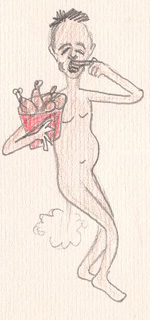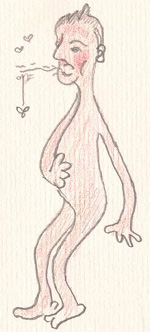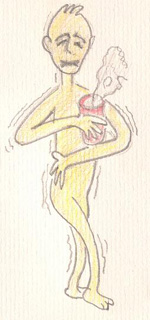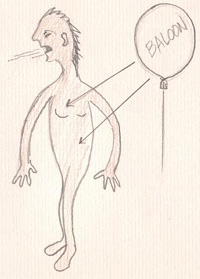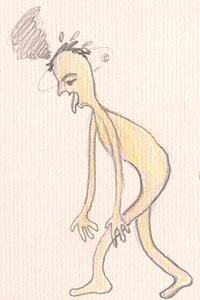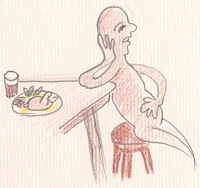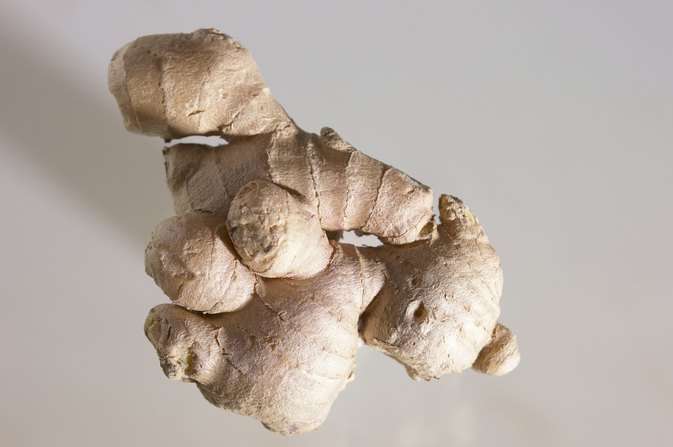In the recent interviews on the initial version of WeCare Holistic's app mock-up, however, I got quite a few laughs or doubts about the sample question put there illustrating the idea of an online assessment. So, there you go, I think it's time to quote some contents on this seemingly embarrassing yet quite important health topic so that people understand why this is an important question even for a crude health assessment.
Why important
Your poop is used as a diagnostic tool and is an important indicator of the health of the digestion, particularly the stomach, spleen and intestines. There are a lot of factors to consider when formulating a diagnosis. Below is a list of the most common and most important symptoms so you can determine what your poop is trying to tell you.
What is normal stool
Traditional Chinese medicine considers for an adult, 1 or 2 bowel movements a day is normal. The stool should be formed, not too hard or too soft, it should be easily passed and the colour should be medium brown (not too dark or not too light), the stool should not have any undigested food, nor blood or mucus. The smell of the stool should not be very pungent. Before, during or after bowel movement you should not have any uncomfortable sensations such as; pain or burning around anus.
First, here is a handy chart that tells you exactly what your poop is made of. It does seem a bit alarming that there is that much dead bacteria, a whole 8%. Wow.
Frequency
There are some different ideas about what is considered normal frequency, but Chinese medicine says that it is once or twice a day. If you poop less that this, it is, in TCM terms considered constipation, and going three or more times a day is considered too frequent.
Consistency
A normal poop should be well formed, not too loose, not too dry and floating. Poop that is excessively dry indicates either heat in the intestines, blood deficiency or yin deficiency. Loose stools usually point to a deficiency of the spleen. Loose stools can also mean there is kidney deficiency and sometimes a deficiency of both spleen and kidney. Spleen deficiency is definitely the most common cause of chronic diarrhea, and kidney deficiency is the most common cause of diarrhea in the elderly. The energy of the kidneys gradually declines as we age, and this is why many elderly people suffer with symptoms of kidney deficiency, most commonly chronic diarrhea.
Shape
If your poops are in small pieces and difficult to pass it indicates that there is a qi stagnation in the liver. This can also present with alternating diarrhea and constipation. A common cause of liver qi stagnation is repressed emotions, especially things like anger and frustration, so be sure to express your emotions freely! Another reason that you can have small bitty poops that are difficult to pass, especially if they are also dry is heat in the intestines. Eating yin foods that moisten the body and intestines will help keep things moving.
Long, thin poop that looks like a pencil indicate a deficiency of spleen qi. It is also good to be aware that this can indicate cancer, so be sure to see your health care practitioner if this persists. Peace of mind is worth a lot!
Colour
When I am talking to my patients about their poops, I always ask about colour. The normal colour for poop is light brown. Poops that are dark yellow indicate heat in the large intestine, light yellow deficiency heat of the spleen (empty heat is heat due to a deficiency), dark or black looking stools can mean that there is blood stagnation usually in the large intestine. Pale or white poop usually mean that there is cold in the large intestine. If you have green poop is means that the liver is invading the spleen. Red poop indicates the presence of fresh blood which is usually due to heat in the large intestine. Green or blueish poops usually mean that there is cold in the intestines and is very common in babies as their spleens have not yet fully developed.
Smell
How your poop smells is also significant. Strong smells usually indicate heat and absence of smell indicate cold. Here are the details…
A strong, foul smell indicates heat or damp heat in the intestines. A sour smell means that there is an imbalance between the liver and spleen. Lots of gas means liver qi stagnation, gas with a foul smell indicates damp heat and gas with no smell means that there is spleen deficiency.
Diarrhea
Loose stools generally mean that there is a deficiency of the spleen, kidneys, or both. Spleen deficiency is definitely the most common reason for chronic diarrhea and kidney deficiency is the most common cause of diarrhea in the elderly. If there is very severe and watery diarrhea it indicates a deficiency of yang, whereas loose stools are due to a spleen deficiency. Diarrhea accompanied by a foul smell indicates heat in the intestines and diarrhea without a smell is either considered normal or points to cold. If there is pain with the diarrhea it means either liver qi stagnation, cold, or damp heat. If there is mucus in the stool it means that there is dampness, whereas if there is blood is points to a spleen deficiency (the spleen holds blood). Undigested food in the stool means that there is a spleen deficiency. If there is a burning in the anus there is damp heat in the intestines. If you notice that there are streaks in the toilet as the poop is sticky, this also points to dampness in the intestines.
Constipation
Constipation is the most common problem of the bowels, and is more common in women and very common in the elderly. In these cases it is very often due to a blood deficiency or kidney deficiency. Both blood and kidney deficiency would cause the stools to be dry and difficult to pass. Constipation is characterized by infrequent passing of the stools, excessive dryness as well as straining or difficulty in passing the stools. You can, of course, have an attack of acute constipation that comes with heat in the body due to a cold or flu, and will be accompanied by thirst, fever and a red tongue.
Constipation that is relieved by having a bowel movement is due to either retention of food or dampness in the intestines. Constipation with abdominal pain and distension is due to liver qi stagnation. Frequent stools that are not loose is usually due to qi sinking of spleen qi.
Pain
Pain is associated with pooping is also common and it is good to know what it means and when to see your acupuncturist to get it sorted out.
Pain before a bowel movement is due to liver qi stagnation. Pain during a bowel movement is due to either dampness in the large intestine, retention of food or cold in the large intestine. Pain due to retention of food will be relieved by pooping and pain due to cold in the large intestine will not be relieved by moving the bowels. If you are having pain after a bowel movement, it is most likely due to spleen qi deficiency. If you are having persistent pain associated with your poops, be sure to go and have it checked out.
Examine Your Stool
Normally, an individual is able to defecate once or twice per day without straining. The stool should neither be too hard nor too soft, and should not have a foul odor. There also should be no pus, blood, mucus or undigested food in it. A TCM physician usually notes the frequency, form and color of the stool as well as the accompanying feelings during defecation.
Normally, an individual is able to defecate once or twice per day without straining. The stool should neither be too hard nor too soft, and should not have a foul odor. There also should be no pus, blood, mucus or undigested food in it. A TCM physician usually notes the frequency, form and color of the stool as well as the accompanying feelings during defecation.
| Nature of stool |
|
|
|
Constipation
Constipation refers to infrequency or difficulty in defecation and may be accompanied with dry or hard stool. In TCM, this is usually due to heat accumulating in the intestines or insufficient amounts of body fluids. This leads to the intestines being unable to perform peristalsis (special movements of the intestines by which the contents are moved along the cavity). TCM categorizes the condition into four types:
Constipation refers to infrequency or difficulty in defecation and may be accompanied with dry or hard stool. In TCM, this is usually due to heat accumulating in the intestines or insufficient amounts of body fluids. This leads to the intestines being unable to perform peristalsis (special movements of the intestines by which the contents are moved along the cavity). TCM categorizes the condition into four types:
| Heat type: This is caused by excessive heat consuming the body fluid making the content in the bowel unable to flow freely. Individuals defecate dry or hard stools. Other accompanying symptoms are a flushed face, low-grade fever, thirst, foul breath, abdominal fullness and abdominal distention with pain that does not go away with pressure placed on the abdomen. On examination, the tongue is red, covered by a yellow dry fur; the pulse is rapid. | ||
| Cold type: Individuals have difficulty in defecation with dry or normal stool texture. Other symptoms include abdominal distention with pain that does not go away with pressure placed on the abdomen, a pale complexion, cold limbs, an aversion to cold temperatures and a preference to drink hot beverages. On examination the tongue is pale, and the pulse is deepand slow. This is a pattern of cold evil invasion that results in depression of the yang qi and obstruction of the bowel's qi. |
|
| Qi type: The individual presents with constipation or difficulty in defecation even though he or she has an urge. The usual associated symptoms are fullness in the chest and rib sides, frequent belching and a poor appetite. On examination, the tongue is covered by thin and greasy fur; the pulse is taut. | ||
| Deficiency type: Individuals have an urge to defecate but it is difficult, and, many persons will try forceful straining to release the stool. In some cases, extremely dry hard stools like sheep feces are discharged. Other usual symptoms are a pale complexion, dizziness and fatigue. On examination, the tongue is pale; the pulse is fine and hesitant. This is a pattern of insufficiency of the blood and body fluids, or, it is due to deficiency of both qi and yin. It is often seen in chronic disease states, in the elderly and women who have just given birth. |
|
Diarrhea
Diarrhea means frequent defecation with loose or watery stools. TCM believes this symptom is mainly caused by an attack of exogenous evils, improper diet or yang deficiency in both the spleen and kidneys, which make water descend and cause dysfunction in the intestines. TCM divides the condition into the following six types:
Diarrhea means frequent defecation with loose or watery stools. TCM believes this symptom is mainly caused by an attack of exogenous evils, improper diet or yang deficiency in both the spleen and kidneys, which make water descend and cause dysfunction in the intestines. TCM divides the condition into the following six types:
| Damp cold type: Individuals present with diarrhea characterized by loose and watery stools. The stools are pale yellow and have a foul odor. Other accompanying symptoms are a bland taste in the mouth, fullness in the epigastric (the upper middle region of the abdomen), abdominal pain, intestinal rumblings and a poor appetite. There may be alternating chills and fever accompanied by headache, nasal congestion and general soreness. On examination, the tongue is covered by thick white fur; the pulse is slow and hesitant. | |
| Damp heat type: Individuals usually start with abdominal pain followed by diarrhea, and pass formless and foul odor stools with great frequency. Other symptoms include intestinal rumblings, restlessness, thirst and a burning sensation in the anus. On examination, the tongue is red and covered by yellow, thick and greasy fur; the pulse is rapid. |
| ||||
| Food retention type: Individuals have foul smelling diarrhea with sour and rotten vomit, fullness of the epigastric region, intestinal rumblings, abdominal pain that is diminished after fecal discharge, a poor appetite and fever. On examination, the tongue fur is thick and greasy; the pulse is rolling. This is often due to eating unhygienic food or an improper diet. | |
| Spleen yang deficiency type: Individuals have diarrhea or may just pass loose and soft stool. There is undigested food in the stool. Other symptoms include poor appetite, increased stooling frequency after eating greasy foods, abdominal distention, a dull pain above the navel, a sallow complexion, fatigue and general weakness. On examination, the tongue is pale, enlarged and covered by white fur; the pulse is weak. |
| ||||
| Hyperactive liver qi attacking the spleen type : Individuals have abdominal pain and diarrhea following emotional disturbances. The abdominal discomfort will slightly diminish after defecation. Accompanying symptoms include fullness in the chest and rib sides, belching, loss of appetite, a bitter taste in the mouth, acid regurgitation, a sallow complexion and fatigue. On examination, the tongue is pink with little fur; the pulse is taut. | |
| Kidney yang deficiency type: This is due to the kidney yang failing to warm the spleen. Individuals present with abdominal pain at dawn and then pass a loose stool. The abdominal pain is relieved after defecation. There is also coldness and soreness present in the lumbar area and knees. Distension in the abdominal region and aversion of coldness are typically present. On examination, the tongue is pale and enlarged; the pulse is deep and fine. |
Blood in the stool
- Stool mixed with fresh blood and foul in odor is often due to an attack of heat evils in the meridians and blood vessels.
- Dysentery: Both blood and mucus are present in the stool. Other symptoms include abdominal pain, fever, tenesmus (rectal heaviness) and abdominal urgency. This is a result of damp-heat in the large intestine.
- Black, tar-liked stool is due to blood stasis, which indicates bleeding in the upper portion of the digestive system.
- Red, bloody stool indicates bleeding in the lower portion of the digestive system..
- Blood in the stool should always be evaluated by a physician as it can be a symptom of some serious medical conditions.
Fecal incontinence
This occurs when an individual is unable to control defecation and the stool is discharged out spontaneously. It pertains to yang deficiencies in the spleen and kidneys.
This occurs when an individual is unable to control defecation and the stool is discharged out spontaneously. It pertains to yang deficiencies in the spleen and kidneys.
Source:
https://www.pingminghealth.com/article/1334/what-does-abnormal-stool-mean/
https://www.chinesemedicineliving.com/acupuncture/what-your-poop-is-telling-you/
http://www.shen-nong.com/eng/lifestyles/tcmrole_urine_exam_stool.html
